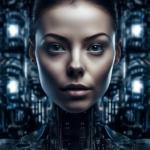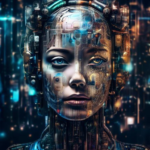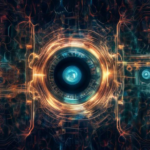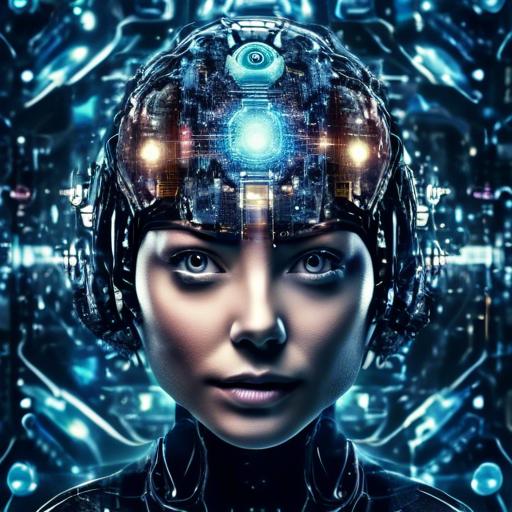Imagine walking through a vibrant art gallery where every brushstroke tells a story, every splash of color evokes an emotion. Now, picture an artist who never sleeps, never tires, and whose potential is as limitless as the human imagination. This artist is not bound by flesh and bone but is an intricate symphony of algorithms and data – this artist is artificial intelligence. In our ever-evolving world, AI has begun to delve into the sacred realm of human creativity, particularly in the arena of image creation. Whether it’s generating breathtaking landscapes, whimsical characters, or abstract masterpieces, AI is learning to mimic the ineffable spark of human ingenuity. Join us as we explore this fascinating confluence of technology and artistry, and uncover how these digital brushstrokes are painting a future where machines and human minds create beauty together.
Table of Contents
- Understanding the Fundamentals of AI and Creativity
- The Evolution of Image Creation: From Brushes to Bytes
- Decoding Neural Networks: The Brain Behind AI Artwork
- Techniques and Algorithms: The Building Blocks of Digital Dreams
- Exploring GANs: Where Collaboration Sparks Creativity
- Case Studies: AI Art That Transcends Pixels and Paint
- Empowering Artists: How AI Amplifies Human Imagination
- Ethical Considerations: Balancing Innovation and Integrity
- Practical Tips for Artists: Integrating AI into Your Creative Process
- In Conclusion
Understanding the Fundamentals of AI and Creativity
Artificial Intelligence has made remarkable strides in recent years, transitioning from a mere buzzword to transformative applications across various domains. One of the most captivating demonstrations of AI’s capabilities is its role in image creation, where it aims to mimic human creativity.
**The Mechanics Behind AI Image Creation**
At its core, AI image creation leverages deep learning algorithms, particularly Generative Adversarial Networks (GANs). These networks consist of two main components: the generator and the discriminator. The generator creates new images, while the discriminator evaluates them against real images. Over time, the generator improves, producing images increasingly closer to those created by humans.
**Key Benefits**:
– **Speed**: AI can generate images at a pace far beyond human capacity.
- **Consistency**: Ensures uniformity in style and quality.
– **Endless Creativity**: AI can mix and match styles in ways humans might not consider.
**Applications in Various Industries**:
– **Fashion Design**: AI helps in creating new clothing designs by analyzing trends and suggesting innovative combinations.
– **Art**: Artists use AI as a cooperative tool to inspire new visual art forms.
– **Marketing**: Advertisers leverage AI-created imagery to tailor campaigns swiftly tailored to different demographics.
| Industry | Usage Example |
|---|---|
| Fashion | Designing new apparel |
| Art | Creating unique paintings |
| Marketing | Personalized ad visuals |
**Challenges and Ethical Considerations**:
Despite its remarkable capabilities, AI’s role in image creation is not without challenges. One significant concern is the ethical implications of AI-generated art, such as ownership rights and the potential loss of jobs for human artists. Moreover, ensuring that AI-generated content does not perpetuate biases present in training data is a critical challenge.
AI’s ability to mimic human creativity in image creation is not just about replicating what already exists but rather unlocking new possibilities and expanding the horizons of what is achievable. The synergy between human imagination and AI’s computational prowess promises a future where creativity knows no bounds.
The Evolution of Image Creation: From Brushes to Bytes
From the strokes of cave paintings to the precision of Renaissance masterpieces, the evolution of image creation has always mirrored technological advancements. Today, as we stand on the cusp of a new epoch, **artificial intelligence (AI)** is transforming the way we perceive and produce art. This metamorphosis isn’t just a shift from physical tools to digital counterparts—it’s an entirely new paradigm where machines learn, imitate, and eventually innovate visual art.
AI’s journey from simple algorithms to sophisticated neural networks has paved the way for groundbreaking tools like **Generative Adversarial Networks (GANs)** and **Deep Learning frameworks**. By dissecting vast datasets of images, these AI models can identify patterns, styles, and even context, enabling them to create images that are remarkably human-like. Consider the fascinating realm of neural style transfer, where an AI can paint a modern photograph in the style of Van Gogh or Monet. The synthesis of classic and contemporary aesthetics speaks volumes about the machine’s ability to understand and replicate artistic nuances.
Several AI-driven platforms are democratizing image creation, making advanced tools accessible to both professional artists and novices alike. **Key features** of these platforms include:
- Intuitive Interfaces: User-friendly designs that cater to diverse skill levels.
- Style Adaptation: The ability to mimic various artistic styles with precision.
- Collaborative Tools: Features that facilitate co-creation between humans and AI.
In the realm of photography, AI’s capabilities extend beyond simple filters. Sophisticated algorithms can enhance image resolution, balance lighting, and even generate entirely new photographs from textual descriptions. Platforms like **DALL-E** and **DeepArt** are pioneering this movement, pushing the boundaries of what’s possible with machine learning and creative algorithms.
| AI Tool | Key Feature |
|---|---|
| DeepArt | Neural Style Transfer |
| DALL-E | Text-to-Image Generation |
| Runway ML | Real-time Image Synthesis |
| Artbreeder | Collaborative Creation |
In this transformative landscape, the role of human creativity is evolving rather than diminishing. While AI offers unprecedented tools and techniques, the soul of art remains deeply human. It’s our ability to imbue these creations with emotion, narrative, and intent that sustains the timeless allure of art. As we continue to innovate, a harmonious blend of human and artificial creativity promises to redefine the horizons of visual expression.
Decoding Neural Networks: The Brain Behind AI Artwork
With a foundation in mathematics and inspired by biological processes, neural networks serve as the intricate frameworks enabling AI to generate stunning, original artwork. These sophisticated systems function like a digital brain, with layers of algorithms working together to simulate the way human neurons interact and process information.
At the core of these networks are three essential layers: the **input layer**, the **hidden layers**, and the **output layer**. The input layer receives raw data, such as image pixels, which is then processed through multiple hidden layers where the magic of “learning” happens. Each neuron in these layers applies specific weights and biases, gradually optimizing to produce the final output—a meticulously crafted image.
- **Input Layer**: Receives raw data like pixels or image descriptors.
- **Hidden Layers**: Process and transform data through various stages.
- **Output Layer**: Generates the final image or creative output.
The pseudo-human creativity of AI in image creation becomes evident when observed through the lens of techniques like **Generative Adversarial Networks (GANs)**. GANs involve two neural networks—a generator and a discriminator—competing against each other in a zero-sum game. The generator creates images from random noise, while the discriminator evaluates them for authenticity. Over time, the generator improves, producing near-indistinguishable artwork compared to traditional human-made images.
| Component | Function |
|---|---|
| Generator | Creates images from random noise. |
| Discriminator | Evaluates and authenticates generated images. |
| Training Loop | Improves accuracy over multiple iterations. |
Another fascinating technique is **Style Transfer**, where the network is tasked with combining the content of one image with the style of another. This involves feature extraction from both images, allowing for the synthesis of a new creation that preserves the primary elements and layout of the content image, marinated with the artistic flair of the style image.
The end result of these technologies is not just an imitation but a celebration of creativity. AI-generated art blends mathematical precision with boundless imagination, breaking traditional barriers and venturing into realms previously thought exclusive to human hands and minds. This groundbreaking fusion of technology and artistry is setting the stage for a new era of creative expression.
Techniques and Algorithms: The Building Blocks of Digital Dreams
At the heart of artificial intelligence’s ability to replicate human ingenuity in image creation lie several **key techniques and algorithms**. These digital building blocks are meticulously designed to understand, reinterpret, and originate visual art in ways that mirror our very own creative processes.
**Neural networks**, especially Convolutional Neural Networks (CNNs) and Generative Adversarial Networks (GANs), are instrumental. Here’s a glimpse into their roles:
- CNNs: Primarily used for analyzing and identifying patterns within images, CNNs excel at tasks like object recognition and feature detection. They break down visuals into digestible pieces, understanding elements such as color, texture, and shape.
- GANs: The real virtuosos of creativity, GANs consist of two parts: a generator that creates images and a discriminator that evaluates them. This adversarial dance pushes the generator towards producing increasingly realistic and sophisticated visuals.
In the canvas of AI-driven artistry, **style transfer algorithms** paint with a different brush. These algorithms allow an image’s style to be superimposed onto another, effectively merging two separate artistic visions. Whether it’s turning a photograph into a Van Gogh masterpiece or blending modern graphic design with Renaissance art, style transfer blurs the lines between human and machine creativity.
Below is a simplified comparison of these major algorithms:
| Algorithm | Primary Function | Use Case |
|---|---|---|
| CNN | Pattern Recognition | Object Identification |
| GAN | Image Generation | Art Creation |
| Style Transfer | Artistic Merging | Style Blending |
To dive even deeper, **recurrent neural networks (RNNs)**, although more prevalent in sequence prediction, also contribute by understanding contextual patterns over time, thereby improving the predictive aspects of image generation and refinement. The way RNNs can enhance image sequences or generate plausible alterations based on past data showcases their latent artistic prowess.
The synergy of these algorithms doesn’t just stop at creating images. AI’s collaborative approach mirrors human teamwork, where different specialties converge to produce something exceptional. This technological symphony ensures that AI not only mimics human creativity but often complements and expands upon it in unprecedented ways.
Exploring GANs: Where Collaboration Sparks Creativity
The journey into the world of Generative Adversarial Networks (GANs) feels like opening a portal to a collaborative creative universe, where two neural networks—the Generator and the Discriminator—interact in a delicate dance of creation and evaluation. These two networks are like artistic rivals, each pushing the other to new heights of creativity.
GANs have revolutionized how we think about AI creating art. The **Generator** attempts to create images from random noise, while the **Discriminator** evaluates them, distinguishing between the real images and the ones produced by the Generator. Over time, this process of adversarial training fuels innovation and refinement, resulting in images that can perplex even the most discerning human eye.
| Component | Role | Outcome |
|---|---|---|
| Generator | Creates images | Progressively more realistic images |
| Discriminator | Evaluates images | Sharpens Generator’s skill |
The allure of GANs lies in their collaborative essence. These networks, through continuous feedback, not only contest but complement each other, producing results that are sometimes astonishingly original. **From landscapes to surreal compositions**, the artistic potential harvested from GANs is practically limitless. This symbiotic relationship transforms the creative process into a dynamic playground.
Imagine a world where painters and illustrators have virtual assistants that can draft initial concepts based on verbal descriptions, or where architects can generate unprecedented building designs with a simple sketch. GANs embody a future where collaboration with AI isn’t just a concept but a tangible tool for sparking human creativity.
- Virtual art exhibitions: Display collections of GAN-generated art side by side with human-created pieces, blurring the lines between digital and traditional mediums.
- Customized artwork: Generate unique pieces of art tailored to personal tastes and preferences, opening new avenues in personalized art curation.
The integration of GANs into our creative workflow empowers both professional artists and casual hobbyists. Their ability to inspire, assist, and even surprise with unexpected possibilities makes them indispensable allies in the ever-evolving realm of artistic expression.
Case Studies: AI Art That Transcends Pixels and Paint
Exploring how artificial intelligence is redefining the boundaries of art opens up a multitude of fascinating case studies in which AI transcends traditional artistic mediums. One exemplary case is the partnership between AI and the iconic Japanese artist, Yayoi Kusama. With the help of AI, Kusama’s infinite polka dots have been brought to life in new, mesmerizing patterns that evolve dynamically, providing viewers with an ever-changing visual feast.
AI is not just a tool but a collaborator in the creative process. A prime example is the collaboration between AI and artist Robbie Barrat, who utilizes neural networks to create stunning, surreal pieces of art that challenge the norms of human imagination. Barrat leverages AI to generate thousands of iterations of his work, selecting the most compelling results to finalize. This co-creative process has birthed a new genre where human intuition meets machine precision.
- Dynamic transformation of classical art
- Fusion of historical techniques with modern algorithms
- Breaking the barriers of static imagery
Consider the groundbreaking project conducted by Sofia Crespo and Feileacan McCormick, where AI was trained to emulate the intricacies of biological organisms. Their work, often described as “neurography,” merges AI with biological aesthetics, crafting otherworldly yet eerily familiar forms. This melding of AI and biology has opened up new avenues for exploring the visual representation of life forms unseen by the human eye.
| Artist | AI Collaboration | Outcome |
|---|---|---|
| Yayoi Kusama | Dynamic polka dots | Ever-changing patterns |
| Robbie Barrat | Neural Networks | Surreal art pieces |
| Sofia Crespo | Biological aesthetics | Neurography |
As AI continues to evolve, so too does its ability to mimic and expand upon human creativity. The fusion of technology with traditional art forms not only adds new dimensions but also invites a deeper conversation about the future of creativity. Whether through dynamic installations, surreal compositions, or biological simulations, AI is proving that it can complement and enhance human artistry in ways previously unimaginable.
Empowering Artists: How AI Amplifies Human Imagination
With the rapid advancement of artificial intelligence, artists now have access to tools that were once the stuff of science fiction. **AI-driven software** complements the human imagination, enabling creators to push the boundaries of their art in unprecedented ways. These digital collaborators don’t just replicate human creativity—they amplify it, offering a unique synergy that enriches the creative process.
One of the magical aspects of these AI tools is their ability to **generate images** from textual descriptions. Have an idea for a scene but can’t quite visualize it? AI can convert your descriptions into a variety of artistic styles, from hyper-realistic to abstract. This means artists can now prototype their visions more rapidly, iterate on them, and even uncover new directions they might not have considered. It’s like having an ever-patient sketch partner who never tires.
Consider the **benefits** AI offers:
- Speed: Generate complex images in seconds.
- Inspiration: Break through creative blocks with new ideas.
- Collaboration: Work alongside AI to refine your vision.
- Customization: Tailor the output to match your unique style.
Here’s a look at how artists are using AI to transform their creative process:
| Application | AI Role | Artists’ Gains |
|---|---|---|
| Concept Art | Generating initial sketches | Rapid ideation |
| Digital Painting | Adding intricate textures | Enhanced detail |
| Storyboarding | Creating scene layouts | Efficiency in planning |
| Fashion Design | Visualizing clothing patterns | Innovative designs |
The symbiotic relationship between artists and AI extends beyond mere tool usage; it creates an inspiring feedback loop. As AI interprets and learns from an artist’s style, it delivers suggestions that can lead to novel artistic breakthroughs. This relationship encourages continuous learning and exploration, opening doors to artistic realms yet unimagined.
Ethical Considerations: Balancing Innovation and Integrity
As AI-powered tools like image generators become increasingly intricate, they offer unprecedented creative possibilities. However, integrating these digital marvels into our creative process comes with significant ethical implications. One pressing concern is ensuring that **innovation** remains grounded in **integrity**.
Consider the potential impact on the labor market. Artists and designers, whose livelihoods depend on their unique creative abilities, may find themselves competing against machines capable of producing art at a rapid pace. It’s essential to initiate dialogues about fair compensation and recognizing the value of human creativity.
- Transparency: Clearly indicate when an image has been AI-generated.
- Accountability: Maintain responsibility for AI’s outputs, especially in sensitive contexts.
- Equity: Ensure diverse datasets to prevent biases in generated content.
Another ethical aspect to consider is the **intellectual property** of AI-generated images. Who owns the rights— the creator of the algorithm or the user who prompts the AI? Defining ownership can be tricky, and it often leads to legal gray areas. Creative professionals must be proactive in understanding and navigating these issues to respect both human and synthetic contributions.
| Ethical Consideration | Potential Solutions |
|---|---|
| Copyright | Licensing frameworks for AI-generated content |
| Bias | Inclusive and diverse training datasets |
| Transparency | Clear labeling of AI-produced work |
Ultimately, the goal is to foster a **symbiotic relationship** between AI and human creativity. By adhering to ethical principles and advocating for rights and fairness, we can ensure that innovation flourishes without compromising the core values of **artistic integrity**.
Practical Tips for Artists: Integrating AI into Your Creative Process
Incorporating AI into your artistic projects may seem daunting, but with the right approach, it can greatly enhance your creative process. Here are some practical tips to help you seamlessly blend AI into your artwork while maintaining the authenticity and originality that defines your style.
**Explore AI-Powered Tools**
- **Generative Adversarial Networks (GANs):** These can help you generate new images by training on datasets and creating variations that would take days to paint manually.
- **Style Transfer Applications:** Tools like DeepArt or Adobe’s Neural Filters can help you apply the artistic style of famous painters to your creations.
- **Sketch-to-Art Software:** Quickly transform your rough drafts into polished works using AI, saving hours of refinement work.
**Experiment with AI-Generated Concepts**
An exciting benefit of AI is its ability to generate ideas you might not think of independently. By setting parameters and letting the AI run wild, you can explore a plethora of unique concepts and styles.
- Use AI to draft several rough ideas and then infuse your personal touch to enhance them.
- Create combinations that you normally wouldn’t consider, broadening your creative horizon.
- Generate new patterns, color palettes, and textures that serve as the groundwork for your pieces.
**Balancing AI and Personal Input**
To ensure that your unique voice remains front and center, balance AI-generated elements with your own input. Here are some tips to maintain that crucial equilibrium:
| **AI’s Contribution** | **Your Contribution** |
|---|---|
| Initial rough ideas and mood boards | Personalized refinement and detailing |
| Basic forms and structures | Specific features and original elements |
| Application of renowned styles | Adding personal stylistic tweaks |
**Stay Updated with AI Innovations**
AI technology evolves rapidly, bringing new tools and functionalities that can further assist in your creative endeavors. Staying informed about these advancements is key:
- Follow tech blogs and journals that focus on AI advancements in the art world.
- Join online artist communities where you can share and gain insights about integrating AI into art.
- Attend webinars and workshops that demonstrate the latest AI-powered techniques and tools.
By thoughtfully incorporating AI into your creative process, you’ll not only enhance your current artworks but also open doors to new artistic possibilities. Remember, AI is a tool meant to complement your artistry, not replace it.
In Conclusion
AI has truly revolutionized the world of image creation by mimicking human creativity in remarkable ways. By harnessing the power of artificial intelligence, we are able to push boundaries, explore new frontiers, and redefine what is possible in the realm of visual art. Embrace this exciting journey of innovation and discovery, and together let’s continue to push the limits of creativity with AI as our faithful partner in crime. The future of image creation is boundless and brimming with endless possibilities – let’s create, inspire, and dream together. Remember, the art that moves us is the art that moves us forward.
































